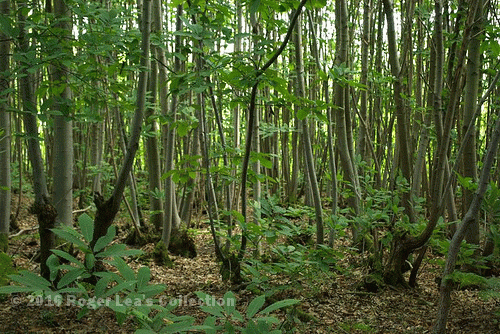The art of managing woodland so that it produced a regular supply of the right kind of timber and other products developed over thousands of years, and was well understood in Medieval Sutton Coldfield. You had to surround the wood with a ditch and a bank with a fence on top so that animals could not get in and eat the seedlings and new coppice growth. Trees were felled so that new shoots would grow up from the base of the trunk, and after a given number of years, when the resulting poles had grown to the desired size, they too were harvested. The remaining tree stumps (or stools) produced a new crop of shoots, and so the cycle , called coppicing, would continue indefinitely. In 1569 a Sutton coppice was let on a seven-year lease, which suggests that the Sutton coppices were on a seven-year cycle.
The Sutton coppices were administered by the Lord of the Manor’s bailiff for the benefit of the whole community, and coppices only feature in the records when someone had to be fined for breaking the rules. Offences included breaking the fences, taking poles and underwood without permission (i.e. before the coppice was due to be harvested) and putting animals in to graze before the coppice had grown (the coppice would be opened up to grazing once the leaves were out of reach).
Offences were dealt with at the Court Leet, and eleven different coppices are named in the sixteenth century court rolls. These ranged in size from twenty to forty acres; from north to south they were: Hawkshurst Coppice (near Little Hay); Bradnocks Hayes (at the end of Worcester Lane); Hill Wood (near the bend in Hill Wood Road), Roughley Coppice, Wythen Hill Coppice (near the dip in Withy Hill Road), Hawksnest Coppice (at Falcon Lodge), Lynryche Coppice (now Langley Mill Pool), Redway Coppice (Reddicap Heath), Hurst near Shipton, which may be the same as Sidnalhay Coppice (Signal Hayes), and Echilhurst Coppice.
Sutton ceased to be a manor and became an incorporated town in 1528, but the customs of the manor continued to be observed - the surviving court rolls begin in 1546. The coppices gradually fell out of use in the next century as the woods in Sutton Park became the main source of woodland products for the townsfolk. By 1800 all the coppices had gone, added to farmland, or thrown open to the commons, leaving only their names behind.
